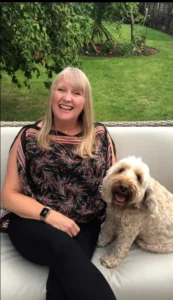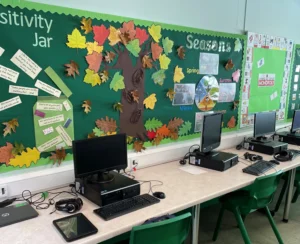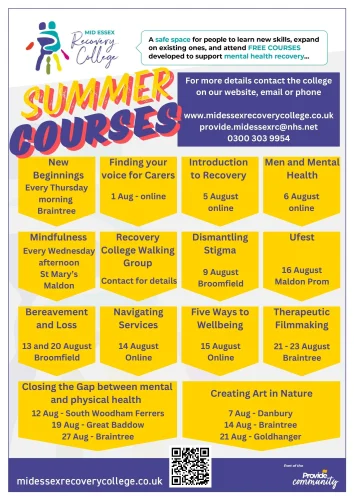Friday 14 October is Developmental Language Disorder (DLD) Awareness Day. DLD causes difficulties with speaking and understanding for no known reason. DLD is thought to affect one in fourteen people and has serious and long-term impacts, particularly putting children at greater risk of failing at school and struggling with mental health and causing problems with future employment. Find out more about DLD Awareness Day.
Katherine Farrow has worked at Provide Community for eight years within enhanced provision and has been the Children’s Speech and Language Therapy (CSLT) team lead for four years. Katherine is passionate about her work and, alongside her day job and MBA studies is ready to launch a ground-breaking new programme Give a Child a Voice, which she hopes will be adopted nationally.
What’s your role within CSLT? As well as being team lead, I work clinically within a secondary enhanced provision in a high school, so I have both management and clinical responsibilities.
Where are you based? On management days I work from home, and my clinical days are based at the Speech and Language Centre (the enhanced provision) at Notley High School.
How does a typical day start? Whether I’m working from home or the clinic, my day always starts with a coffee and a walk with my dog Rosa.
What happens at the Speech and Language Centre (SLC)? The SLC is a specialist provision for children with Developmental Language Disorder. We have 20 places for young people who have an education health and care plan, and for whom speech, language and communication needs (SLCN) is the primary need. It is a nurturing environment, which promotes self-esteem and confidence, as well as working on individual targets.
I work with the young people on an individual basis or in small groups. After detailed assessment of their skills, care plans are devised which focus on their individual needs. These may target development of their vocabulary, grammar, comprehension, and communication skills etc. I also support the staff working within the base, to ensure they are aware of the individual needs of the children and how they can help support them.
What sort of outcomes do you see? I have worked with a young man for the last five years and have seen him transform from a nervous, under confident child into a young man who asks questions, seeks clarification and is able to use a range of skills that support his understanding. He has benefited hugely from regular speech and language intervention and responded well to the support offered within the enhanced provision. He recently left school, achieving a range of GCSE passes and has been offered an internship at a local school supporting young children, which he hopes to do alongside college.
Another child received regular speech and language therapy for a severe speech disorder, which gradually improved during his time at the SLC. There was a residual difficulty when he came to leave, but he had grown hugely in confidence. In fact, he found the confidence to join a drama club and began to make friends closer to his home, where he eventually attended college. He benefitted from the regular intervention which focused on extending the range of his speech sounds, but also encouraged self-confidence and self-esteem.
What do you like best about your job? I love the mix of management and clinical work. Seeing therapists in the team develop their skills and respond to challenges in innovative ways is inspiring. Clinically, when children begin to respond to therapy and there is a change in their overall presentation, where SLCN is less impactful, is so encouraging. I love to see them thrive! By the time the young people leave school, my hope is that they can independently use strategies which will support them throughout their lifetime, and they can fully engage with college and work in the future.
How important is colleague support in your role? The CSLT team are vital in delivering much needed therapy to children. Without their constant support and hard-working nature, outcomes for families would not be as positive as they are. Their support of me whilst I completed my studies was central to my ability to complete the course. Many covered for me whilst I studied and attended modules, and I am extremely grateful for that.
Within SLC, I work closely with the SENCo and the learning mentors who support the children in their classes. The close working relationship ensures children receive the best level of care and support.
Tell us about your study and what it has entailed I have just completed a two-year Master of Business Administration (MBA) Degree Apprenticeship. Provide released me for six hours per week to complete the off-the job-training required as part of the apprenticeship and enabled me to focus on my studies.
The MBA comprised completion of 12 modules and a work-based dissertation project, focusing on improving an area of need within the service. Modules focussed on topics such as leadership, entrepreneurship and innovation, organisational change etc.
What dissertation subject did you cover and why? My dissertation is based on something I am very passionate about – raising the profile of speech, language and communication needs (SLCN). I wanted to prove the concept of developing a new funding stream, so that speech and language therapy services could be extended to children with ongoing needs, whilst also raising awareness of SLCN within the community.
Give a Child a Voice aims to seek new connections with local and national companies, and as sponsorship is secured, to form ‘Communication Partnerships.’ These partnerships will enable investing organisations to access intranet and training resources, devised by SLTs, which will provide information about SLCN and how it might present within their own workforce, raising awareness and understanding. Many children with SLCN go on to have long-term difficulties which do not resolve and appreciating how these difficulties present in adulthood will help and support the inclusion of these individuals within their working community.
Why is Give a Child a Voice so important to you? I see it as a two-pronged approach. Not only will it enable children to receive additional therapy which will help enhance their life-chances, it also raises awareness of SLCN within the adult population and encourages inclusivity in the workplace, making it a more welcoming and understanding environment. The young people I work with are future employees of organisations. Their difficulties will continue into adulthood, and it’s important for them to know their employer will be knowledgeable and accepting of their difficulties.
How have you put the programme together? Three care packages have been devised, and a schedule of delivery planned, which is based on half-termly intervention blocks. It is linked closely to the academic school year and requires a minimum investment of £1500 to commence the programme, and £9000 to run it in full. It will rely on philanthropic/CSR funding with no expectation of return. The pandemic drove the way forward for teletherapy to develop, and the initiative provides opportunities for this mode of delivery to take centre stage for some of its clients, with the creation of an iCafe. It also encourages SLT student participation, extending the offering of clinical placements within the team, which will help maintain the workforce pipeline.
What would you like to happen next with Give a Child a Voice (GaCaV)? I would love to secure sponsorship to ensure the programme can get off the ground. I have had some very encouraging conversations with a range of organisations who are interested in supporting the programme (including Starbucks UK). People seem to understand the need and would like information to help them understand how they can support them. Social Value is at the heart of the GaCaV. It is an exciting opportunity for all those involved. Together, within a business ecosystem focused on community: understanding; awareness, and inclusion can be nurtured, and lives can be enriched.
If you could wave a magic wand for your service, what would your three wishes be? More capacity to meet the needs of all the children in our care and have flexibility to offer support to families and educational placements when it’s appropriate and needed.
Opportunities to reward those therapists that go over and above what’s required, to ensure children get the best possible service.
For Give a Child a Voice to thrive = To have the time to raise awareness within our local community of SLCN and the impact it has on children, young people and adults, ensuring changes are made to environments so that those individuals can flourish and achieve their potential, adding to the richness of the diversity around us.




